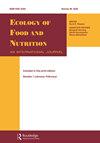2019冠状病毒病期间的粮食不安全:脆弱性、健康状况和采取行动。
IF 1.7
4区 医学
Q4 NUTRITION & DIETETICS
引用次数: 2
摘要
本文章由计算机程序翻译,如有差异,请以英文原文为准。
Food Insecurity during the Time of COVID-19: Vulnerability, Health Conditions, and Taking Action.
Since the report of the first cases of a “viral pneumonia” in Wuhan, China in late 2019, the global spread of what would be identified as SARS-Co V-2 or COVID19 has been rapid and virulent. As of August 2021, there were 214.8 million COVID-19 cases and nearly 4.5 million associated deaths (Johns Hopkins Coronavirus Resource Center 2021b). While some countries have made strides in containing the spread of the virus through quarantining, social distancing, and mandatory mask-wearing, many others have not. For example, there were 28 million cases and over 400,000 deaths in the U.S. at the end of January 2021 (Johns Hopkins Coronavirus Resource Center 2021a). As of August 2021, there are now 38 million confirmed cases and over 633,000 deaths in the U.S. (Johns Hopkins Coronavirus Resource Center 2021b). Although there are now vaccines to immunize millions, their rollout and availability have been problematic, even in countries with highly developed healthcare and public health systems. In the U.S. where the vaccine has been available since December 2020, only 52% of the population is fully immunized but this figure varies depending on the age group (e.g., older adults are more likely to be vaccinated) and where people live (e.g., higher rates of vaccination in the northeast). Vaccine hesitancy and skepticism have led to a lower vaccination rate of 108 doses per 100 people (Our World in Data 2021). Notwithstanding the speed of the development of these vaccines, the challenges of scaling up production on a global basis means that vaccine herd immunity will not happen any time soon (Weixal 2021). In an attempt to increase equity of access to COVID-19 vaccines, the WHO, Gavi, and CEPI have partnered to create COVAX, a public-private coalition of governmental organization and philanthropists dedicated to vaccine donation and price negotiation for lower-income countries (Gavi, The Vaccine Alliance 2021a). While some countries, such as Ghana, Zambia, and the Democratic Republic of Congo have only recently begun to receive COVAX-donated vaccine doses, wealthier and more populous nations
求助全文
通过发布文献求助,成功后即可免费获取论文全文。
去求助
来源期刊
CiteScore
3.50
自引率
0.00%
发文量
23
审稿时长
>12 weeks
期刊介绍:
Ecology of Food and Nutrition is an international journal of food and nutrition in the broadest sense. The journal publishes peer-reviewed articles on all aspects of food and nutrition -- ecological, biological, and cultural. Ecology of Food and Nutrition strives to become a forum for disseminating scholarly information on the holistic and cross-cultural dimensions of the study of food and nutrition. It emphasizes foods and food systems not only in terms of their utilization to satisfy human nutritional needs and health, but also to promote and contest social and cultural identity. The content scope is thus wide -- articles may focus on the relationship between food and nutrition, food taboos and preferences, ecology and political economy of food, the evolution of human nutrition, changes in food habits, food technology and marketing, food and identity, and food sustainability. Additionally, articles focusing on the application of theories and methods to address contemporary food and nutrition problems are encouraged. Questions of the relationship between food/nutrition and culture are as germane to the journal as analyses of the interactions among nutrition and environment, infection and human health.

 求助内容:
求助内容: 应助结果提醒方式:
应助结果提醒方式:


